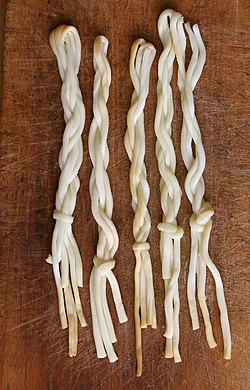Top Qs
Timeline
Chat
Perspective
String cheese
Elongated type of cheese From Wikipedia, the free encyclopedia
Remove ads
String cheese is any of several different types of cheese where the manufacturing process aligns the proteins in the cheese, making it stringy.
When mozzarella is heated to 60 °C (140 °F) and then stretched, the milk proteins line up.[1][2] It is then possible to peel strings or strips from the larger cheese.
Remove ads
Regional variants
Summarize
Perspective
United Kingdom
In the United Kingdom, a popular version of string cheese is Cheestrings, manufactured by Kerry Dairy Ireland.[3] The cheese is manufactured using grass fed cows milk which is matured into a mild flavour. The cheese is heated, stretched and then cut to size for retailing.[4]
Central and Eastern Europe
In Slovakia, korbáčiky are made,[5] which is a salty sheep's milk cheese, available smoked or unsmoked. It is traditionally made by hand-pulling steamed sheep's cheese into strings and braiding them. Cow milk versions are also available.[6][7] The town of Zázrivá is known as the center of the production of this cheese. Similar cheeses are found also in the adjacent regions of South Poland.
West Asia
In Turkey, the most common type of string cheese is dil peyniri ("tongue cheese"), a fresh white cheese made from cow's milk, traditionally in the provinces of Bilecik and Bursa. The stringy texture of dil becomes even more prominent when the cheese is melted.[8]

In Armenia, traditional string cheese, chechil, is made with a white base. The type of milk used usually comes from an aged goat or sheep depending upon the production methods of the area of choice.[9] It is seasoned with black cumin[10] and mahleb, and is traditionally sold in the form of a braided endless loop.[11] The cheese forms into strings due to how it is pulled during processing. It is also made in Syria and Turkey, both countries with significant Armenian populations.
In Syria, string cheese is known as jibneh mshalleheh. It contains spices such as mahleb, cumin, anise, and caraway.[12]
Russia is the primary importer of chechil, having an 80% market share for Armenian cheese exports, attributed to its sizeable Armenian diasporas.[13][14]
In Georgia string cheese is known as tenili (ტენილი ყველი [ka], Тенили [ru]). It is made from fermented sheep's milk and cream allowed to mature for 60 days in a salted and dried veal stomach.
Mexico
In Mexico, the first type of string cheese was invented in 1885 by Leobarda Castellanos García at 14 years old. A very popular type of string cheese called quesillo is sold today in balls of various sizes. It is also known as Oaxaca cheese or "queso Oaxaca", referring to the place where it was invented, and now it's widely popular in all Mexican territories.[citation needed]
United States

In the United States, string cheese generally refers to snack-sized servings of low-moisture mozzarella. This form of string cheese is roughly cylindrical, about 6 inches (15 cm) long and less than 1 inch (2.5 cm) in diameter.
The cheese used is commonly a form of mozzarella, or a combination of mozzarella and cheddar. This type of string cheese gets its name because it can be eaten by pulling strips of cheese from the cylinder along its length and eating these strings.[15] It was invented in 1976 by Frank Baker.[16]
Central America and Caribbean
In the Dominican Republic "Queso de Hoja" is produced in the form of a ball. It is mostly served with toast or crackers.
Oceania
In Australia, string cheese is sold by the Bega Group and is called Bega Stringers.[17][18]
Remove ads
See also
References
External links
Wikiwand - on
Seamless Wikipedia browsing. On steroids.
Remove ads

